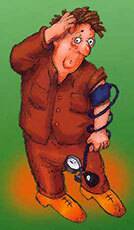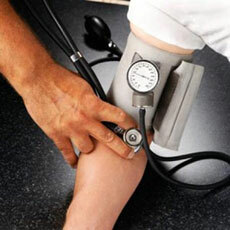Portal hypertension in cirrhosis of the liver is considered the most dangerous complication of organ atrophy. Pathological process develops at a high pressure in the portal vein, accompanied by characteristic symptomatology. The group risk fall predominantly men over 40 years with long-term alcohol abuse. The pathology is characterized by a high risk of death, which are used to prevent surgical and drug therapies.

Causes
The pathological process progresses with circulatory disorder in liver vessels. As a protective measure in the body begins increase in pressure in the portal vein. Depending on the type of portal hypertension is classified following the disease causes:
- Suprarenal. The disease occurs on the background of thrombosis hepatic veins or the appearance of a malignant tumor that compresses the vessel.
- Intrahepatic. In most cases the etiology is portal cirrhosis, accompanied by a narrowing of the vessel lumen due to pressure on it from outside the nodes formed connective tissue.
- Obstructive. The resulting blood clot stops the blood flow in the vessels of obstructive.
- Mixed. The combination of the above pathologies characterized by impaired blood supply.
manifestations
Signs of portal hypertension seen against the background of high blood pressure in the hepatic portal vein. Indicators reach 12 mm Hg. Art. and continue to grow. Depending on the symptomatic pattern distinguish 3 stages of disease development.
Predastsiticheskaya stage
At this stage the progression of the disease symptoms are not manifested pathology. The disease occurs in a latent form. the following symptoms occur in rare cases:
- nosebleed;
- gradual strengthening of the clinical picture of hemorrhoids;
- esophagus expansion;
- weakness, deterioration of the general state of health.

Depending on the degree of severity of the disease the patient begins to complain of:
- fatigue even after mild to moderate physical activity;
- weight loss;
- heaviness in the stomach and pain in the epigastric region;
- nausea, vomiting;
- male erectile dysfunction;
- weakness, chronic fatigue;
- bloating and flatulence in the intestine;
- disruption of the menstrual cycle in women;
- cyanosis - pallor and blueness of the skin;
- the spread of hemorrhagic lesions;
- redness of the skin on the hands;
- gynecomastia - breast enlargement in men.
A decrease in the plasma concentration of hemoglobin and proteins, particularly albumin. At the same time, increases in blood levels of bilirubin and y-globulin. Urinalysis reveals the presence urobilin. In carrying out X-ray observed expansion of the stomach and esophagus.
ascites stage
During this phase, portal hypertension is characterized by the occurrence of the following symptoms:
- sharp decline of forces;
- marked weight reduction;
- fatigue, reducing efficiency;
- fluid collection in the abdominal cavity;
- dryness and peeling of the skin;
- inflammation of nervous tissue.

At external survey indicated an increase in the size of the stomach and jellyfish symptom - abdominal visually visible veins, which gradually expanded. Auscultation instead of the sound of a bell marked the noise in the organs. The study of blood there is a low level of white blood cells, platelets and hemoglobin. At the stage of ascites increases the risk of an inguinal hernia.
cachectic stage
The final stage of development of the pathological process begins after the occurrence of ascites. In most cases, life goes from 6 months to 2 years. Cachectic stage is characterized by the following symptoms:
- ascites, is not amenable to treatment;
- critical depletion - cachexia;
- jaundice;
- bleeding in the esophagus and stomach;
- exacerbation of opportunistic infections on the background of a weakened immune system.

Lethal outcome occurs when a coma, in which a man falls from the progressive bleeding from varices and severe exhaustion.
Laboratory and hardware diagnostics
If you suspect that the emergence of forms of cirrhosis portal physicians must collect anamnesis and clinical study comparing the identified symptoms. To clarify the diagnosis additional testing using the following methods:
- General blood analysis. The procedure allows to detect changes in the number of formed elements, it helps determine pancytopenia. Hypersplenism develops with an increase in spleen size.
- Blood chemistry. BAK allows to reveal the activity of hepatic transferases ALT and AST, by which to determine the degree of progression of the disease.
- Abdominal ultrasound. Ultrasound examination allows to assess the structural state of the hepatic parenchyma and portal vein. US confirms or denies the development of ascites, and also allows you to set the distribution of the connective tissue.
- A study using an endoscope. At impossibility of computed tomography and radiography for visual examination of the digestive tract used optical device diagnostics. Alternative examination helps to analyze the current state of varicose veins of the esophagus and digestive system.
- Splenomanometriya. This procedure applies to the X-ray studies. Waldman is performed using the device. With portal hypertension apparatus shows an increase in pressure in the spleen above 230-250 mm. Hg. Art.

Treatment
Treatment of portal hypertension, liver cirrhosis is directed at eliminating the disease etiology. It is important to remember that the replacement of dead hepatocytes connective tissue is irreversible. Maintenance therapy is aimed at reducing the likelihood of complications and removal of symptomatic picture.
Diet
The patient should eat in accordance with a special diet therapy №5, reducing the burden on the liver and the digestive system. Allowed to use the following products:
- lean meat;
- beans;
- cereal porridges on water;
- low-fat dairy products;
- fruits and berries non-acidic varieties of vegetables;
- confectionery;
- crackers;
- soups made from vegetables;
- vegetable oil and butter;
- weak tea.

It is strictly prohibited to include in the diet:
- fried, smoked, pickled and spicy food;
- alcohol;
- mayonnaise;
- broths based on meat and fish;
- fresh bread;
- chocolate and cocoa;
- cream, ice cream, coffee;
- sorrel, onions, garlic, radishes and spinach.
medicines
On predastsiticheskoy stages required to completely eliminate the use of alcohol. During this period, prescribers, preventing progression of the disease. Depending on the etiology, severity of illness and the individual characteristics of the organism administered following groups of drugs:
- gepatoprotektory that enhance tissue regeneration and normalize the body;
- diuretics necessary to remove excess fluid from the body;
- adrenoceptor blockers;
- ACE inhibitors.

Symptomatic treatment.
It is strictly forbidden to independently adjust the dosing regimen or use other drugs. The therapy of portal hypertension in liver cirrhosis is entitled only to the attending physician.
Surgery
In some cases, the patient is prescribed treatment with surgery:
- puncture of the abdominal cavity in order to remove liquid;
- grafting with subsequent excretion of blood from the organ necessary for reducing the pressure in the vessels;
- liver transplantation at destruction of more than 80% of the cells.
Traditional methods
Caution should be exercised when using certain herbs, which include calendula and chamomile. Prepared on the basis of their teas have a diuretic effect. Drink infusions need 3 times daily with 150 ml. When the deterioration of the required immediate withdrawal of therapy.

It is important to remember that the application of national treatment for cirrhosis is inefficient and may impair the general condition. Before using the techniques necessary to consult with your doctor.
Complications and forecasts
When liver failure there is the likelihood of the following complications:
- Bleeding in the stomach and esophagus. Rupture of the veins is not felt, so a person can die from severe blood loss. Can be determined by the appearance of bleeding melena - black chair.
- Malignant neoplasms of the liver.
- Ascites.
- Erosive lesions of the digestive tract.
- Uterine and nosebleeds.
- Umbilical, inguinal or femoral hernia.
- Liver failure.
- Intoxication on the background of the collapse of the plasma proteins.
- brain damage.
Complications increase the risk of death.
The pathology is characterized by slow progression with the appearance of exacerbations. With the rapid diagnosis increases the chances of a favorable prognosis. With early detection and proper treatment of the disease life expectancy of patients is 9 years or more. If the fluid begins to accumulate in the abdominal cavity, the risk of death increases. With the development of the second stage of the patient's life is 24 months, during which the patient's body is exposed to coma and infectious diseases.



